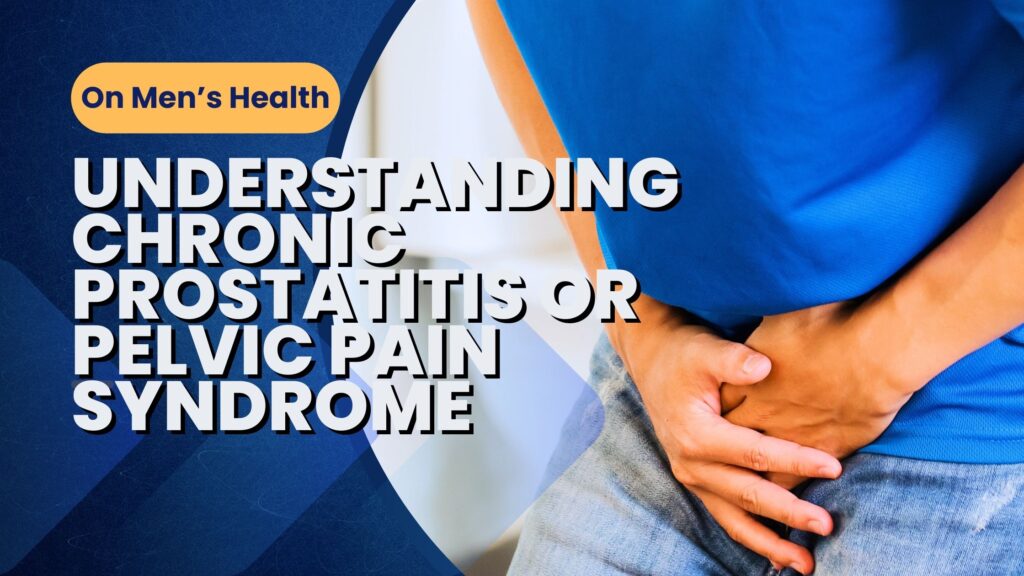Chronic Prostatitis and Pelvic Pain Syndrome (CP/CPPS) are complex and multifaceted conditions that significantly impact men’s health. Characterized by persistent pelvic pain and discomfort, these disorders can severely affect quality of life. This article provides an in-depth analysis of CP/CPPS, including its types, causes, diagnostic methods, and management strategies.
Understanding Chronic Prostatitis and Pelvic Pain Syndrome
Chronic Prostatitis and Pelvic Pain Syndrome (CP/CPPS) are intricate conditions with varying symptoms and underlying causes. These disorders often involve significant discomfort and persistent pain in the pelvic region, impacting both physical health and emotional well-being.
The complexity of CP/CPPS arises from its multifactorial nature, where interactions between biological, psychological, and environmental factors play a crucial role. The condition is characterized by symptoms that do not necessarily correlate with observable pathology, making diagnosis and treatment challenging. This multifaceted aspect underscores the necessity for a thorough and individualized approach to both understanding and managing CP/CPPS.
Defining CP/CPPS
Chronic Prostatitis and Pelvic Pain Syndrome (CP/CPPS) is a complex condition characterized by persistent pelvic pain that does not result from a urinary tract infection. It represents a significant diagnostic challenge due to its heterogeneous nature and the absence of a singular, identifiable cause. CP/CPPS is classified into several subtypes, each with distinct clinical features and diagnostic criteria:
-
Type I: Acute Bacterial Prostatitis
Escherichia coli, Klebsiella, or Proteus are common bacterial pathogens that cause acute bacterial prostatitis, a severe, acute infection of the prostate gland. This form of prostatitis presents with a rapid onset of symptoms, including a high fever, chills, and intense pelvic pain.
Patients often experience dysuria, urinary retention, and systemic signs of infection. The condition demands immediate medical intervention to prevent complications such as sepsis or abscess formation.
-
Type II: Chronic Bacterial Prostatitis
Chronic bacterial prostatitis is characterized by a persistent bacterial infection in the prostate gland. Unlike acute bacterial prostatitis, this subtype presents with a more insidious onset and a chronic course. Symptoms include recurrent pelvic pain, dysuria, and sometimes asymptomatic periods interspersed with flare-ups.
The diagnosis often involves identifying bacterial pathogens in prostatic secretions or urine cultures. Treatment can be challenging, as it typically requires prolonged courses of antibiotics and may involve a combination of antimicrobial therapies.
-
Type III: Chronic Prostatitis/Chronic Pelvic Pain Syndrome (CP/CPPS)
The most common form of CP/CPPS is Type III, which stands out because it causes chronic pelvic pain without showing signs of bacterial infection. It is subdivided into two main categories:
If you have Type IIIA (Inflammatory CP/CPPS), there are inflammatory cells in the prostatic secretions or biopsy samples, which means there is an inflammatory response. Patients with Type IIIA may experience significant pain and discomfort, but the underlying etiology remains poorly understood. This inflammation may be related to autoimmune reactions or other non-infectious causes.
Type IIIB (Non-inflammatory CP/CPPS): In this subtype, inflammatory cells are absent in the prostatic secretions or biopsy samples. Patients with Type IIIB experience pain without an obvious inflammatory process, which can make diagnosis and treatment more challenging. This type is often linked to pelvic floor dysfunction, neurogenic inflammation, or psychosomatic factors.
-
Type IV: Asymptomatic Inflammatory Prostatitis
Asymptomatic inflammatory prostatitis is identified through histological examination of prostate tissue, typically obtained via biopsy. This form of prostatitis does not present with clinical symptoms, making it challenging to diagnose without a specific histological evaluation.
Although asymptomatic, it may be discovered incidentally during evaluations for other conditions or prostate cancer screening. The clinical significance of this subtype remains a subject of ongoing research, particularly regarding its potential role in long-term prostate health.
Each subtype of CP/CPPS requires a tailored diagnostic and therapeutic approach, as their management can vary significantly based on underlying causes and symptom profiles. To accurately diagnose, a full evaluation must be done, including a patient history, physical exam, laboratory tests, and imaging studies. This helps to tell the difference between these subtypes and determine the best way to treat them.
Pathophysiology and Etiology
Pathophysiological Mechanisms
The pathophysiology of Chronic Prostatitis and Pelvic Pain Syndrome (CP/CPPS) is complex and not fully elucidated, but several key mechanisms are thought to contribute to the development and persistence of this condition:
1. Inflammatory Processes
Chronic inflammation is a central feature of CP/CPPS, and it can occur independently of bacterial infection. Various factors, such as:
- Autoimmune Reactions: There is evidence suggesting that CP/CPPS may involve autoimmune mechanisms where the body’s immune system mistakenly attacks its tissues, including the prostate. This immune response can result in persistent inflammation and pain, despite the absence of pathogens.
- Hypersensitivity Responses: Some patients may experience hypersensitivity reactions where the immune system overreacts to harmless stimuli, leading to chronic inflammation and symptoms. This can involve local inflammation within the prostate or pelvic region without clear evidence of infection.
- Prostatic Secretions: Looking at the prostatic secretions of people with CP/CPPS may show inflammatory cells and mediators, like cytokines and chemokines, that cause inflammation and symptoms in the area.
2. Neurological Factors
Alterations in neurological function can significantly impact the manifestation of CP/CPPS symptoms. This may involve:
- Nerve Sensitization: Chronic pain in CP/CPPS may be associated with sensitization of pelvic nerves, where normal stimuli are perceived as painful. This sensitization can occur due to prolonged inflammation or nerve injury.
- Central Sensitization: Changes in central nervous system processing can amplify pain perception. Central sensitization involves increased responsiveness of the central nervous system to stimuli, contributing to heightened pain sensitivity and persistent symptoms.
- Neurogenic Inflammation: The interaction between nerve endings and immune cells in the prostate and pelvic region may contribute to neurogenic inflammation, where nerve-induced inflammation exacerbates pain and discomfort.
3. Pelvic Floor Dysfunction
Dysfunction of the pelvic floor muscles is a significant factor in CP/CPPS. Key aspects include:
- Muscle Tension and Spasm: Hypertonic pelvic floor muscles can lead to pain, discomfort, and functional impairment. This muscle tension may result from or contribute to chronic pelvic pain.
- Pelvic Floor Trauma: Injury or strain to the pelvic floor, potentially from trauma or repetitive stress, can alter muscle function and contribute to persistent pain and dysfunction.
- Coordination Issues: Abnormalities in the coordination and strength of pelvic floor muscles can affect bladder and bowel function, leading to further discomfort and pain.
4. Psychosomatic Factors
Psychological and emotional factors can play a significant role in the development and exacerbation of CP/CPPS:
- Psychological Stress: Chronic stress and anxiety can contribute to the severity of CP/CPPS symptoms. Stress may exacerbate muscle tension, alter pain perception, and impact overall health.
- Emotional Impact: Emotional distress, including depression and frustration, can influence the perception of pain and contribute to symptom persistence. The interplay between psychological factors and physical symptoms can create a feedback loop that exacerbates the condition.
- Cognitive and Behavioral Factors: Behavioral responses to pain, including avoidance or hypervigilance, can affect pain management and coping strategies, influencing the overall experience of CP/CPPS.
Understanding these pathophysiological mechanisms is crucial for developing effective treatment strategies and addressing the multifaceted nature of CP/CPPS. A comprehensive approach that considers inflammatory, neurological, musculoskeletal, and psychosomatic factors is essential for managing this complex condition.
Diagnostic Approaches
1. Clinical Evaluation
Diagnosis of CP/CPPS involves a comprehensive clinical evaluation, including:
- Patient History: Detailed assessment of symptoms, onset, duration, and impact on quality of life.
- Physical Examination: Digital rectal examination (DRE) to assess prostate size, tenderness, and consistency.
- Symptom Questionnaires: Utilization of standardized questionnaires such as the National Institutes of Health Chronic Prostatitis Symptom Index (NIH-CPSI) to quantify symptoms.
2. Laboratory and Imaging Studies
- Urinalysis: To rule out urinary tract infections and other conditions.
- Prostate Secretions Analysis: Examination of prostatic secretions for signs of infection or inflammation.
- Imaging Studies: Transrectal ultrasound (TRUS) or magnetic resonance imaging (MRI) to evaluate prostate anatomy and detect abnormalities.
Management and Treatment Strategies
1. Pharmacological Interventions
- Antibiotics: For cases involving bacterial infection, appropriate antibiotic therapy is crucial.
- Anti-inflammatory Agents: Non-steroidal anti-inflammatory drugs (NSAIDs) may be used to alleviate pain and inflammation.
- Alpha-Blockers: These can help relax prostate and bladder neck muscles, improving urinary symptoms.
- 5-alpha-reductase Inhibitors: Used in cases where benign prostatic hyperplasia (BPH) is a contributing factor.
2. Non-Pharmacological Therapies
- Pelvic Floor Physical Therapy: Targeted exercises and manual therapy to address pelvic floor dysfunction and alleviate pain.
- Biofeedback Therapy: Helps patients gain control over pelvic floor muscles and reduce pain.
- Lifestyle Modifications: Dietary adjustments, stress management, and regular physical activity can improve overall symptoms and quality of life.
3. Advanced Therapies
- Prostate Massage: May offer temporary relief by improving circulation and reducing congestion.
- Intraprostatic Injection Therapy: Injection of medications directly into the prostate to reduce inflammation and pain.
- Surgical Interventions: Reserved for cases unresponsive to conservative measures, including procedures to address underlying anatomical abnormalities or persistent infection.
Prognosis and Long-Term Management
Prognosis
The prognosis of CP/CPPS varies depending on the subtype and individual response to treatment. While many patients experience significant symptom relief with appropriate management, some may continue to experience chronic symptoms.
Long-Term Management
Ongoing management involves regular follow-up with healthcare providers to monitor symptoms, adjust treatment strategies, and address any emerging issues. A multidisciplinary approach, including urologists, pain specialists, and physical therapists, can enhance outcomes and support overall well-being.
Conclusion
Chronic Prostatitis and Pelvic Pain Syndrome represent significant challenges in men’s health. Through comprehensive diagnostic approaches and a combination of pharmacological and non-pharmacological treatments, effective management of CP/CPPS is achievable. Early diagnosis and tailored treatment plans are essential for improving patient outcomes and quality of life. Continued research and advancements in treatment strategies hold promise for better understanding and addressing these complex conditions.
READ MORE: Prostatitis: Treatments and Distinctions
Prostatitis: A Comprehensive Overview of Treatments and Distinctions
Contact Us for Chronic Pelvic Pain Treatment for Men

If you are experiencing symptoms of Chronic Prostatitis or Pelvic Pain Syndrome, prompt medical attention is essential. Reach out to the Arizona Center for Chronic Pelvic Pain for a thorough diagnosis and individualized treatment. Our team of specialists is dedicated to addressing pelvic pain conditions with precision and care.
To schedule an appointment, call us at (480) 599-9682 or email [email protected]. We offer comprehensive evaluations, customized treatment plans, and compassionate support designed to provide relief and improve your quality of life. For additional information and answers to common questions, visit the AZCCPP YouTube channel, where Dr. Michael Hibner provides valuable insights.
Understanding the symptoms, causes, and treatment options for Chronic Prostatitis or Pelvic Pain Syndrome is crucial for effective management and achieving better health outcomes.

